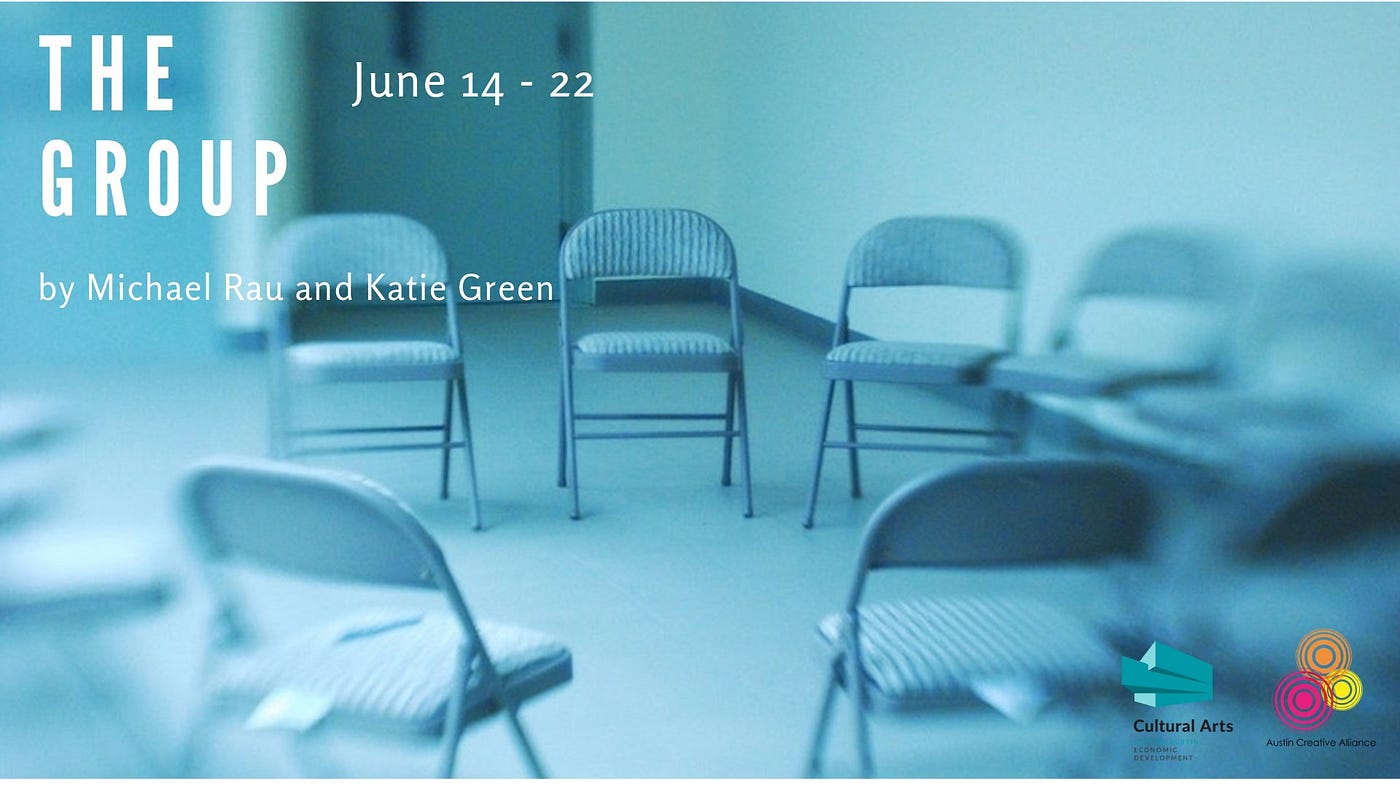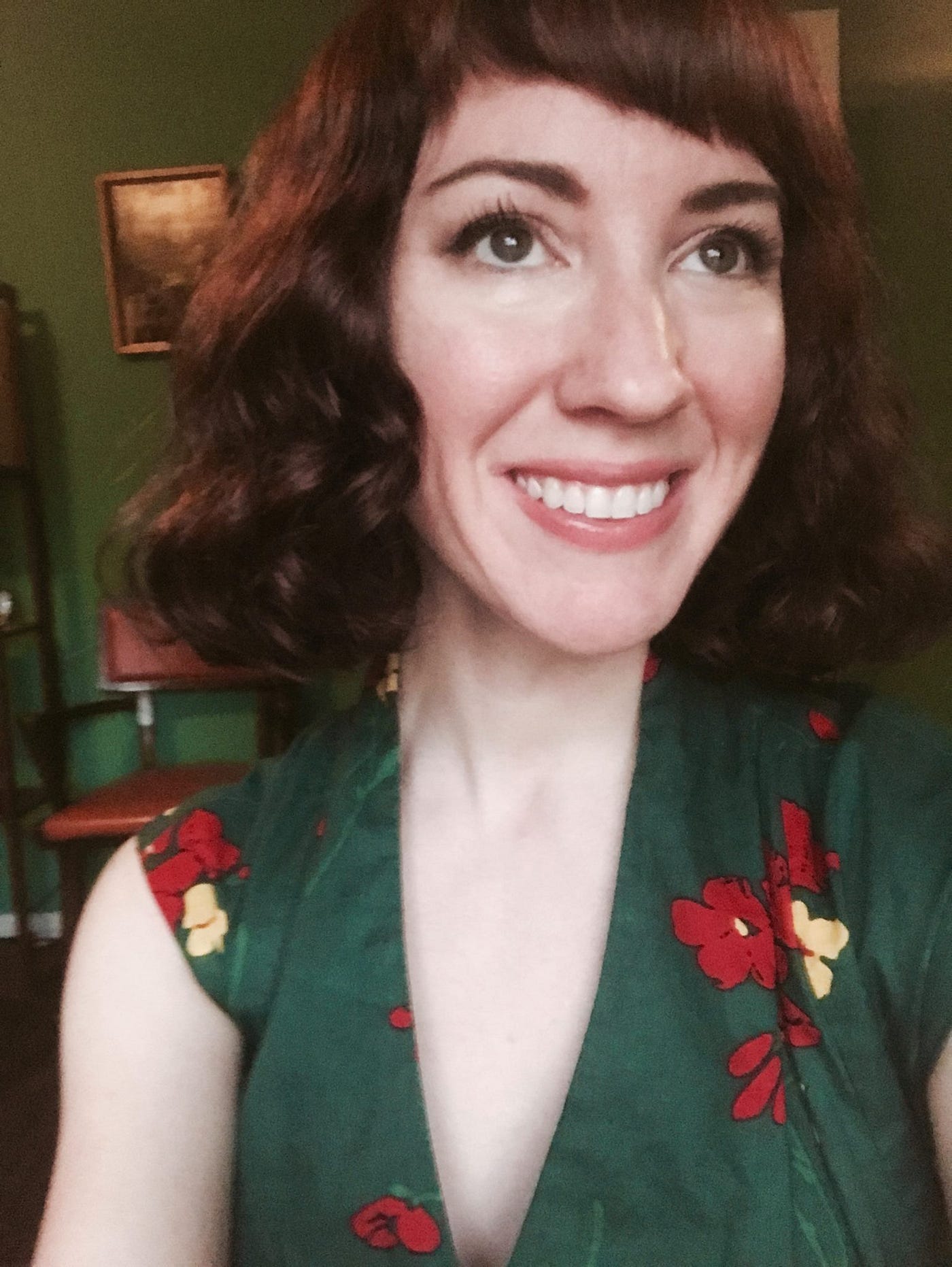
The Group is an intimate exploration of grief and death within the safe container of fictional relationships and live action-roleplaying, created by Katie Green (Twin Alchemy Collective) and Michael Rau (Block Association Project). Participants are paired up as siblings, spouses, or friends, and then split into two grief support groups: one for the living and one for their dead.
Over the course of two hours, the groups run concurrently in real time, each group without knowledge of the other. NoPro NYC correspondent Asya Gorovits said of the experience, “[b]eing dead for three hours allowed me to appreciate being alive and grateful for the opportunity to be able to communicate my feelings and thoughts to others,” and called The Group “tactfully executed and tastefully designed.”
The experience returns to Austin this weekend. We spoke with Katie and Michael over email to learn more about The Group.
No Proscenium (NP): Can you tell us a little about yourselves and your background in making immersive art?

Katie Green (KG): I am the artistic director of Twin Alchemy Collective, an experimental theatre company based in Austin, TX. My work has been produced in NYC, Chicago, Denmark, and Austin. I have trained at the Eugene O’Neill Theatre Center, Double Edge Theatre Company, and Dell’Arte International School of Physical Theatre.
In 2018, I also worked with Meow Wolf to design an immersive, experiential scavenger hunt at SXSW. Last summer, I was a fellow in Odyssey Works’ inaugural experience design master class. I’m currently developing a magical realist video game with my creative partner and creating a service that helps terminally ill people design and will experiences to their surviving loved ones.

Michael Rau (MR): I am a live performance director specializing in new plays, opera, and digital media projects. I’ve worked internationally in Germany, Brazil, the UK, Ireland, Canada, and the Czech Republic. I have created work in New York City at Lincoln Center, The Public Theater, PS122, HERE Arts Center, Ars Nova, The Bushwick Starr, The Brick, 59E59, 3LD, and Dixon Place. Regionally, my work as been seen at the Ingenuity Festival in Cleveland OH, and the American Repertory Theatre in Cambridge, MA.
I’ve developed new plays at the Eugene O’Neill National Playwrights Conference, the Lark and the Kennedy Center. I am a recipient of fellowships from the Likhachev Foundation, the Kennedy Center, and the National New Play Network. I also have been a resident artist at the Orchard Project, E|MERGE, and the Tribeca Performing Arts Center. I’ve been an associate director for Anne Bogart, Les Waters, Robert Woodruff, and Ivo Van Hove. And I am a New York Theater Workshop Usual Suspect and a professor of directing and devising at Stanford University.
NP: What, in a nutshell, is The Group about?
KG: The Group is about exploring your own relationship to death and grief within the safety of a fictional character and relationship.
MR: It’s a participatory, audienced-generated theatrical experience that explores grief using the frameworks of a grief therapy group.
NP: Why did you create this experience? What inspired you to tackle such heavy and often difficult subject matter using a participatory framework?
MR: I think that participatory projects like this one often are better suited for examining deep and heavy themes since they ask for an audience’s active involvement. Sometimes I feel frustrated that creators aren’t willing to use these experiences to look at our own lives.
By creating a space to think about our mortality, I hope that we can demonstrate the utility of participatory experiences.
KG: When we’re kids, we learn about how the world works through play. I actually used to play “funeral” with my big, Catholic family growing up. We went to so many funerals at a young age, it was only natural it creep into our play. I think as adults we can utilize the same tools in a more or less sophisticated way to explore difficult subjects. On a personal note, I’m just interested in death generally. I’m enrolled in a death doula certification program, and am exploring ways experience design can help people die the way they want to.
Get Kathryn Yu’s stories in your inbox
Join Medium for free to get updates from this writer.
SubscribeSubscribe
NP: What kinds of choices can the participants make during the experience and how does that drive what happens?
MR: We worked really hard to design an experience that is largely generated by the audience. We wanted our participants to have a great amount of input into the design of their characters and choices. There are clear guard-rails, but most of the experience is designed to give the participants the freedom and comfort to explore characters and topics that they are interested in, using the group and the facilitators as guides.
KG: Honestly, there’s not much that isn’t a choice. You choose your character and the kind of relationship you’d like to explore with your partner (spouse/partner, parent/child, friends, siblings, etc.), the nature and details of your relationship, which character dies and which character lives, how your character expresses grief, and how your character feels about being dead. We’re not trying to coerce people into feeling sad. Grief can look like denial, anger, numbness, and deflecting with humor. All of those expressions are welcome!
NP: How are you designing around audience agency, consent, and safety, given the subject matter of the piece?
KG: These were all extremely important considerations in our design process, and one of the first conversations Michael and I had when considering this project. We acknowledge that this piece may not be for everyone, especially for someone who is actively grieving. We’re very explicit that this is not a therapy group, nor a substitute for one. We ask that people not create characters or relationships based on real people in their lives.
We teach and employ simple mechanics to signal to the group or their partner that they would like to slow down or change the direction of where things are headed without breaking character. We ask partners to consent to light touch before touching each other. We also tell participants that they may leave at any time for any reason without explanation, and that someone (either Michael or myself) will be available to hold space or process what came up for them privately, so that they don’t just have to leave without a container for their experience.
Finally, we close the experience by debriefing out of character to help participants shake off their character, and give them an opportunity to process anything that may have come up. Fortunately, we have not yet needed to use any of the safety mechanics we’ve built in, but they’re there just in case. Participants have shared that they felt very safe and supported, which I think gives them freedom to go deeper.
NP: What’s the audience response been like so far to The Group?
KG: Really positive! The general response seems to be that this is a weirdly uplifting, life-affirming experience for folks. We’ve also had some people share that this was the first conversation they’ve had about death, which is cool.
NP: Who is the ideal audience member for this experience?
KG: Someone who is open and curious, not there to perform for others but to discover the experience for themselves, and someone who is not in the throes of active grief.
NP: What do you hope participants take away from attending The Group?
MR: I hope that our participants get a chance to reflect on their own life choices, and their current relationships with the people that they are close to, and to either appreciate and value the relationships that they have or be compelled to action to change the way that they are relating to people.
KG: Until recently, I used to actively avoid thinking about or interacting with people who were dying. I realized that people still die whether you’re looking or not. I hope that our participants are just a little more comfortable talking and thinking about their own death and that of their loved ones, so that they will feel empowered to show up in the ways they want to show up.
The Group runs June 14–16, 21, and 22 in Austin, TX.
NoPro is a labor of love made possible by our generous Patreon backers. Join them today!
In addition to the No Proscenium web site, our podcast, and our newsletters, you can find NoPro on Twitter, Facebook, YouTube, Instagram, in the Facebook community Everything Immersive, and on our Slack forum.
Office facilities provided by Thymele Arts, in Los Angeles, CA.



















Discussion